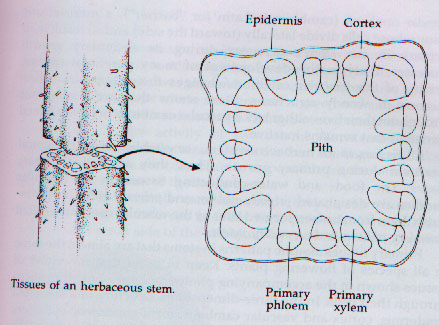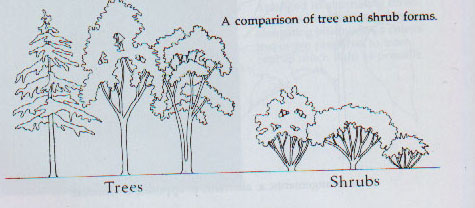Lesson Overview
This lesson is all about the stems of plants. You will look at the functions of stems and how stems are put together to accomplish the functions.
Goals for this lesson
- understand the functions of stems
- be able to identify the different parts of stems
Tasks
- botany lesson 8 worksheet
Vocabulary (note: while it is not necessary to submit written definitions of these words for this lesson, you are responsible for knowing what they mean.)
shoot, twig, branch, trunk, vascular system, woody stem, tree, shrub, xylem, phloem, herbaceous stem, terminal bud, axillary bud, leaf scar, bud scale scar, lenticel, cambium,
Reading
The vascular system inside the stems of all plants forms a continuous pathway from the roots to the leaves through which food and water move.
1) They serve as conduits (pipelines) for carrying water and minerals from the roots upward to the leaves utilizing the xylem tissue and for carrying food from the leaves (where food is manufactured through the process of photosynthesis) down to the roots utilizing the phloem tissue.
2) Stems provide support for the leaves and reproductive structures (flowers, fruit, and seeds) of the plant.
Stems are also used for food storage (as in potatoes and onions) and in plants with herbaceous (green-colored) stems they help manufacture food just as the leaves do.
Stem terminology
Shoot: A young stem with leaves.
Twig: A young stem (one year or less).
Branch: A stem that is more than one year old. Typically a branch has other stems and twigs coming off it.
Trunk: A woody plant's main stem.
Woody Stems: Trees generally have one central stem that is commonly called a trunk. Trees are usually more than 12 feet tall when mature. Shrubs have several main stems and are usually less than 12 feet tall when mature. The stems of trees and shrubs are called woody stems. These stems have large amounts of hardened xylem tissue in the central core (heartwood or sapwood) and a layer of bark on the outside composed of old, inactive, phloem cells.
Herbaceous Stems: The stems of herbaceous plants (basically any plant except a tree or shrub) are not woody. They are usually green and contain only small amounts of xylem tissue and no bark. These plants can be annual (only live for one growing season) or perennial (live for more than one growing season).
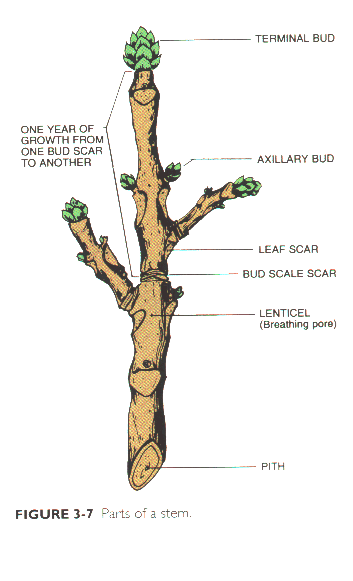
Woody Stems: In order for plants to get access to sunlight and reduce the chances of getting shaded out, they need to be able to grow tall. Tall plants require physical support structures provided by the woody growth in the stems. Having used wood products in houses, boats, and furniture for thousands of years, humans have learned that wood is nature's best product for structural and supportive purposes.
Woody stems have distinctive parts that are illustrated in the photos below. At the tip of each twig, or branch, on a woody plant are buds where primary growth takes place. During the winter these buds, called apical or terminal buds, are encased in bud scales to protect them from the cold. During the spring the bud scales are pushed aside as new growth occurs and the scars where the scales were, mark the beginning of each year's new growth of stem. A twigs age can easily be determined by counting the number of sets of bud scale scars that are on the twig.
A short way down the branch the stem becomes noticeably more hard and 'woody' looking. This is where bark is beginning to form. At first, the bark is smooth and glossy but, with age, it thickens and the surface dries and cracks. Bark protects against water loss and insect or fire damage.
Nodes are areas on a stem where buds are located. These axillary buds are areas of intense cellular activity and growth. At the nodes on a twig are buds that are each potential branches. Below the buds are leaf scars where leaves were previously attached. The space betwen the nodes is called the internode
Scattered bumps on the smooth younger bark are actually breathing pores called lenticels, through which gases, including oxygen pass to and from the living cells in the inner bark.
lenticels on a woody stem leaf scars on a woody stem terminal bud scale scars new growth pushes aside bud scales dormant bud encased in bud scales

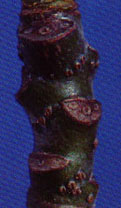
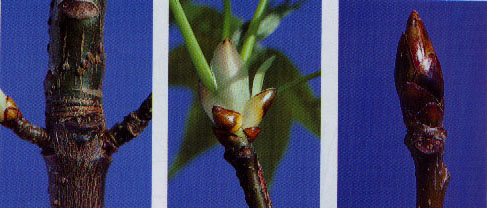
Herbaceous Stems: Herbaceous stems have many of the same features as the woody stems. They lack bark and so are more pliable and soft, and generally last only a year or two. They have axillary and terminal buds, lenticels, and leaf scars.
Internal Stem Structure
In all stems, water and dissolved minerals travel up the xylem from the roots through the stem and to the leaves and buds. At the same time, foods manufactured in the leaves travel down the phloem. The phloem and xylem are in bundles within the stem and are like the pipes in a plumbing system.
Woody Stems: The internal structure of woody stems consists of layers of phloem and xylem separated by a layer of vascular cambium. The cambium layer is a layer of tissue that continually produces new phloem cells toward the outside of the stem (they become bark) and new xylem cells toward the inside of the stem (they become heartwood). This new tissue is responsible for the increase in the diameter of a woody stem over time. All the plants in this group are dicotyledons (have 2 seed leaves upon germination). It is these yearly layers of new cells that produce the rings you see in the stump of a cut down tree.

Herbaceous Stems: The vascular systems of herbaceous stems can be monocotyledons or dicotyledons. Herbaceous stems from dicotyledon plants are very similar to the stems of woody plants described above. The herbaceous stems of monocotyledons are different and are described here. Monocots have vascular bundles that contain both phloem and xylem tissue in each small bundle. There is no layer of cambium so each cell is formed in the initial stage of stem growth and merely enlarge to create the stem of a mature plant.
